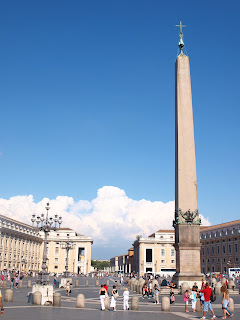During a holiday to Rome in July 2011 I managed to squeeze in some Egyptology-related sightseeing, namely following the trail of obelisks around the city which Labib Habachi dubbed the "City of Obelisks". There are 13 obelisks standing in the city today, more even than in Egypt, and although I didn't have the time to see every one (I only managed to get to 8), I'd like to share some of my holiday snaps of the obelisks that I did see, some of which were inscribed in Egypt then brought to Rome, and others were brought uninscribed from Egypt and subsequently decorated in Rome.
 |
Piazza Della Rotunda Red granite, 6.34m, 19th Dynasty Originally erected by Ramesses II at Heliopolis Now outside the Pantheon of Hadrian |
 | ||||||
Piazza dell' Esquilino Red granite, 14.75m, Unknown date Originally erected on the western flank of the Mausoleum of Augustus Now outside the church of Santa Maria Maggiore |
 |
Monte Citorio Red granite, 21.79m, 26th Dynasty Originally erected by Psamtek II at Heliopolis Now outside the Italian Chamber of Deputies building |
 |
Piazza Navona Red granite, 16.54m, inscribed in Rome Originally erected by Domitian near the Iseum Now in the Piazza Navona |
 |
| Piazza San Pietro Red granite,23.37m, uninscribed Originally erected in the Julian Forum in Alexandria by Augustus Now in front of St. Peters Cathedral |
The remaining obelisks that I didn't see are:
- Monte Pincio (Red granite, 9.25m; inscribed by Hadrian)
- Villa Celimontana (Red granite, 2.68m; originally erected by Ramesses II at Heliopolis, smallest obelisk in Rome)
- Piazza della Minerva (Red granite, 5.47m; originally erected in Sais by Psamtek II)
- Piazza del Quirinale (Red granite, 14.64m; originally erected on the eastern flank of the Mausoleum of Augustus)
- Vialle delle Terme di Diocleziano (Red granite, 9.25m; originally erected in Heliopolis by Ramesses II)
I also managed to find a couple of other Egyptianizing monuments whilst in Rome, I'll be sure to put up those images in a second blog post.
All information after Habachi, L., (1977), The Obelisks of Egypt: Skyscrapers of the Past, London: Biddles Ltd, where you can also find more information about the obelisks I missed on my visit.








